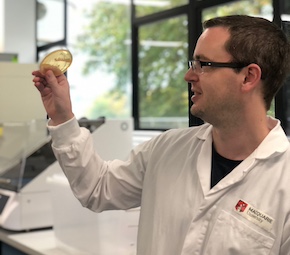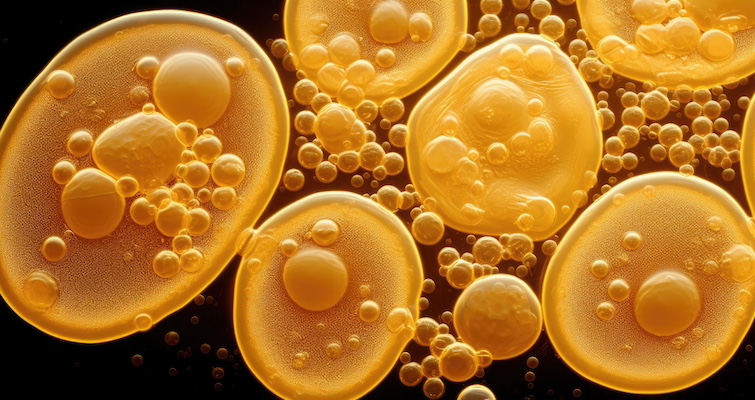Ten year project brings scientists one step closer to re-writing world’s first synthetic yeast genome, unravelling secrets behind the fundamental building blocks of life
Research Fellow Dr Roy Walker, from Macquarie University’s School of Natural Sciences, has spent more than a decade working on a project invisible to the human eye, helping to design and construct a chromosome entirely from scratch that will contribute to the final completion of the world’s first synthetic brewer's yeast (Saccharomyces cerevisiae).

Dr Walker is shared co-first-author on the research published in the November issue of Cell together with Dr Daniel Schindler, group leader at the Max Planck Institute for Terrestrial Microbiology and the Center for Synthetic Microbiology in Marburg, Germany.
Dr Walker and Dr Schindler are part of an international research team led by Patrick Cai at the Manchester Institute of Biotechnology, who have built the tRNA Neochromosome – a chromosome new to nature.
“Life is astoundingly complex. However, we’ve only recently acquired the ability to build and understand this complexity through new advances in technology, such as that of synthetic genomics,” says Dr Walker.
“The tRNA neochromosome shows how ambitious collaborative projects can lead to significant advances in synthetic biology, furthering our understanding of life’s fundamental building blocks.”
He adds the research could unlock new capabilities in the near future ranging from introducing new functions for yeast cell factories, to building neochromosomes which can help us better understand how cancer cells work.
Yeast 2.0 project
The breakthrough forms part of a wider project, Sc2.0 (nicknamed Yeast 2.0 ) which has now successfully synthesised all 16 native chromosomes in Saccharomyces cerevisiae (common baker’s yeast), with the eventual aim to combine them to form a fully synthetic cell.
The Sc2.0 project involves large scale collaboration at an international scale between experts from around the world in fields ranging from biology and genomics to computer science and bioengineering.
The international team has already combined six and a half synthetic chromosomes in a functional cell, in the first instance where scientists have written more than half of a eukaryotic genome from scratch using a computer.
While scientists elsewhere have already built an artificial bacterial genome, building synthetic yeast chromosomes is way more complicated; yeast cells have nuclei (like human cells), and yeast DNA is organised into multiple chromosomes, making their genomes much larger.
Yeasts are a common workhorse of industrial biotechnological processes as they allow valuable chemicals to be produced more efficiently, economically, and sustainably. They are used to produce biofuels, pharmaceuticals, flavours and fragrances, as well as in better-known fermentation processes like bread-making and brewing.
Being able to re-write a yeast genome from scratch could create a strain that is stronger, works faster, is more tolerant to harsh conditions and has a higher yield of useful products.
The process also sheds light on the fundamental operations of genomes - such as how genomes evolve and how they are organised.
Typically, genes are mixed up across the chromosomes, scattered randomly over time by evolution.
However synthetic biology could offer the opportunity to reorganise genes logically, grouping relevant genes together on custom chromosomes, and selecting only necessary genes to make yeast strains more robust.
Researchers could also control how many copies of each gene are present, avoiding unwanted extra genes that slow cell growth.
Scientists could then find out which genes are truly essential and what their functions are. They can also engineer improved yeast strains, like tuning genes for salt and temperature tolerance.

Australian connection
Dr Walker began work on the project in 2013 as part of his PhD at the University of Edinburgh, before moving to Australia to continue the work with Macquarie University’s synthetic biology research team under Professor Sakkie Pretorius, and Distinguished Professor Ian Paulsen at the School of Natural Sciences.
“Macquarie University, and the ARC Centre of Excellence in Synthetic Biology, are leading forces in synthetic biology and play an important role in this international effort,” says Professor Paulsen.
The tRNA neochromosome is used to house and organise all 275 nuclear tRNA genes from the yeast genome and will eventually be added to the fully synthetic yeast where the tRNA genes have been removed from the other synthesised chromosomes.
Unlike the other synthetic chromosomes of the Sc2.0 project, the tRNA neochromosome has no native counterpart in the yeast genome.
Synthetic chromosomes of the Sc2.0 project were designed using computer-assisted design (CAD), manufactured with state-of-the-art roboticized foundries, and completed by comprehensive genome-wide metrology to ensure the high fitness of the synthetic cells.
Next, the researchers will work together to bring all the individual synthetic chromosomes together to form a fully synthetic genome. The final Sc2.0 strain will not only be the world’s first synthetic eukaryote, but also the first one to be built by the international community .
Full paper title: Design, Construction, and Functional Characterization of a tRNA Neochromosome in Yeast